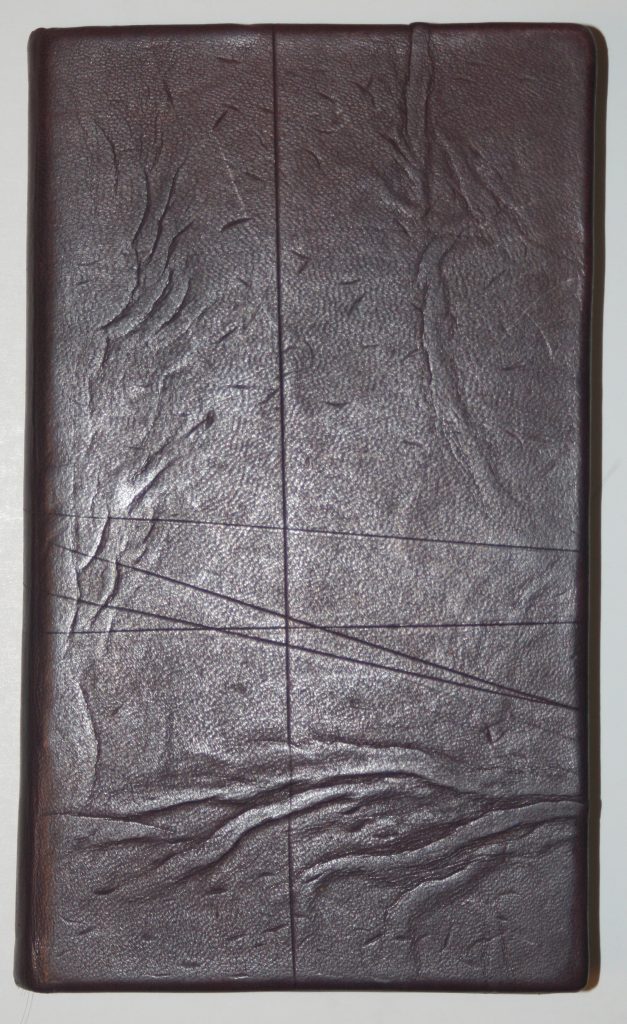Rebecca’s Dairy
1990
The starting point of this work was the Brothers Grimm story of Aschenputtel or Cinderella. My interest was in the part of the story that tells of the death of the girl’s mother and her life before the glamorous balls, the lost glass slipper and the romance with the Prince. I asked myself, if this lonely, unhappy child had written a diary what would she have written? Although it is a personal story it is also a universal story about growing up.

PHYSICAL STRUCTURE.
Size: c.13cm x 20cm. The size is small because it is a private book, portable by necessity, as the girl carries it on her person at all times.
Binding: hard cover, leather binding, plain natural colour with no blocking. It is sewn in 4 sections, each section represents a season; section one is Spring, two is Summer, three is Autumn and four is Winter. Each section is made of 7 leaves, representing the days of the week (or 14 pages, a page being only one side of the leaf) forming a book of 28 leaves representing the lunar month and the human menstrual cycle. Each leaf can be seen to represent a day the two pages of the leaf the night and day of the day.

INTERNAL, PERSONAL STRUCTURE
Thus every event recorded can be seen within the context of the year, according to the season, the lunar/menstrual month and the week; no page is dated, no dates are required.
Other, perhaps obvious, links have been made for the purpose of simplification, (what one could call) ‘natural rhythm’ and structure.
The girl’s (monthly) fertility is recorded or presumed to occur in the first section, which is Spring, the season of regeneration. It is celebrated with new growth appearing on the trees, in particular, the tree on her mother’s grave. It is the season in which she received the twig from her father, the giving and planting of which is, in it’s essence a conception which enables the rebirth of her mother. It is also the season of her own conception and the season of her father’s remarriage.
If her day of fertility is on the twelfth day of her cycle, her menstruation will occur 16 days later, if she has not conceived. 16 pages later the menstruation is recorded and it falls in the autumnal season. If, on the other hand, a woman does conceive in spring, the child will be born in Autumn. Therefore, autumn is the season of the girl’s birthday and the fruiting of the tree, which offers the promise of regeneration through the growth of new trees but also through sustenance given by the food. Also, recorded is the mother’s death symbolized as the tree enters a period of no growth.
The internal, personal structure rocks between these two transitional months. Summer can generally be considered as a month of optimism and warmth and Winter, conversely, a month of depression and low spirits.
The Ashenputtel Trilogy
2011
The trilogy consist of Rebecca’s Diary, the original work made in 1990 in a new binding, a translation of the Brothers Grimm story Ashenputtel and a new work, The Queen’s Diary.

When invited to participate in this exhibition, Happily Ever After, it was obvious to revisit this work. It was interesting going back to it and finding it fresh and appealing. The exhibition required another work. The third part of the work is another diary or journal. Again a question started the process: what did happen to Aschenputtel? Was there a happily ever after? Well we all know that life isn’t like that. Well not in a Walt Disney kind of way! Immediately I knew that any breakdown in Aschenputtel’s happiness would not be caused by a breakdown in her marriage. This seemed too obvious, cliché and also to run against the innocence and honesty of the original story. The Prince is not a cunning or conniving character. His love for Aschenputtel is straightforward and honest and Aschenputtel’s lack of self-seeking her internal strength and resilience suggested to me an integrity that shouldn’t be fouled.

Set years later, Aschenputtel is in prison. The journal is what she writes before her death. Like Rebecca’s Diary it has 56 pages but the rhythmic structure of childhood is gone. It is not clear how long she been in prison or over what time span the journal is written. The charge against her is treason. Her husband, the king has been tossed off the throne by a usurper. Being a political prisoner, and because of her social status, she is in solitary confinement, in that she is kept separate from the other female prisoners. The only time she sees the other women is on Sundays at Mass. The guards are all women. We are once again in a women’s world.

Structure comes to the work through a chant she repeats;
Come Katerina, come and bring me news of the children,
do not come Katerina do not risk your life for me,
Come Katerina come and tell me that they are well and strong and brave,
do not come Katerina do not risk your life for me…
then by a hymn that she hears the other prisoners singing in the courtyard as they go about their self-care chores.
Take my heart, oh Lord, take my pitiful heart
and have mercy on my wretched soul.
Take my heart and my soul to rest in Your heavenly peace.
Before You I am humble,
Before You I am contrite,
Before You I will be pure again.
Take my heart, oh Lord, take my pitiful heart
and have mercy on my wretched soul.
Take my heart and soul to rest in Your heavenly peace.

As in Rebecca’s Diary I do not fill in huge narrative chunks of background information but rather let the narrative generate itself from a given set of facts. Much of the narrative is revealed in her reaction to her circumstances. The guards seem to tease her by calling her ma’am and curtsying has her reveal her humble time as her stepmother’s servant. The priest who refuses to look at his congregation of ‘soiled’ lowly women and chants through the Mass as a duty without compassion, incites Aschenputtel to seethe with anger at the charge laid against her and the higher crime of the usurper king. As she struggles to deal with the powerlessness of her imprisonment and the grief and worry about her husband and their children she refuses to face the likely truth that they have been killed but believes that they have escaped to a safe haven.

I did not know what the outcome of the story would be and it only became inevitable as it drew to a close. I wanted her to escape. But it became clear that to pull this off the story would have to be heavily contrived and that would have trivialised her life! As in the original fairy tale, Aschenputtel remains a person of great integrity and lacks that selfishness that was so dramatically displayed by her stepsisters. When even the opportunity to recant and betray her husband by swearing allegiance to the usurper king she replies; My sins may be many for I am imperfect and fail often as a prisoner in this mortal flesh but against God I have not wilfully sinned not against this man you call king, he is a usurper, a false monarch, a murderer and a brigand against whom a list of crimes as long as my arm can be recorded!
